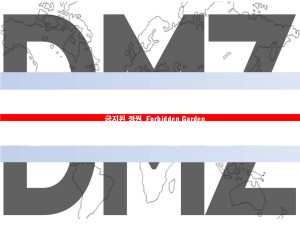“DMZ – Forbidden Garden / Keelatud aed”
Gail Art Museum (Korea)
Kuraator Seong Mi Hong
Olukord Koreas meenutab jalutuskäiku õhukesel jääl, kuna poliitilised pinged on suuremad kui kunagi varem. Põhja-Koread valitsev režiim hirmutab kogu maailma jätkuvalt tuumakatsetustega, kinnistades rahvusvahelise üldsuse kuvandit Koreast kui ebastabiilsest piirkonnast, kus põhja ja lõuna vahel valitseb ületamatu konflikt. Ainsa lõhestunud riigina maailmas, püsib Korea endiselt ebakindlal vaherahul, mida tähistab Gimpo’st Gosung’ini kulgev 248 km pikkune demilitariseeritud tsoon. Rindejoon on igapävane reaalsus, mis teeb Koreast ülisuurte kaitsekulutustega riigi, kus elatakse pidevas sõjalise konflikti ohus.
Seda olukorda ignoreerida näib võimatu. Korealaste jaoks on ühinemine kõige olulisem küsimus konflikti lahendamisel. Pidevas sõjalise kokkupõrke ohus näib aga, et lootus kahe Korea taasühinemisest on siiski hääbumas. Kuidas peaksid kunstnikud käituma taolises ärevas olukorras? Gaili Kunstimuuseumil (Korea) oli võimalus paluda üheksal kunstnikul käsitleda seda teemat näituse “DMZ – Forbidden Garden/ Keelatud aed” raames.
Korea igapäevast reaalsust käsitlevate kunstnike arv ei ole suur, kuid just see paneb neid kuulama. Üheksa näitusel osalevat kunstnikku: Kang Yong Suk, Ko Jung Nam, Kim Yong Tae, Kim Tae Eun, Yoo Yeun Bok, Son Ki Hwan, Song Chang, Lee Bann and Hwang Se Jun, katavad laia loomingulise spektri realistlikus laadis õlimaalist fotograafia ja videokunstini. Nende loomingu kaudu saab meile hoomatavaks lõhestunud riigi akuutne reaalsus.
Bum Mo Yoon
Kunstikriitik
Loe ka “Kuraatori nägemus”
(Rohkem infot inglise keeles postituse all olevates failides)
Näitus jääb avatuks 11. juulini.
“DMZ – Forbidden Garden / Keelatud aed”
Gail Art Museum (Korea)
Curator Seong Mi Hong
Inter-Korean tensions are now r more heightened than ever, just as if we were walking on the thin ice. The regime in the North keeps making threatening remarks about nuclear tests and missile launches. This only confirms the notion in the international society that Korea is a volatile region where South and North are at loggerheads. The only divided country in the world, Korea remains precarious in the state of armistice. Korea is a country with a demarcation line. It is a country divided by the line called the “demilitarized zone (DMZ),” which stretches 155 miles (248km) from Gimpo to Gosung; in other words, a country where the DMZ is a reality; a country where an enormous amount of money is appropriated for defense spending so that we can point guns at each other; and a country on the brink of war because of this demarcation line. How could you ignore such a harsh reality? The most significant issue in this era of overcoming the division is unification. However, the term “unification” seems to be slowly receding as thoughts of war prevail. The mood of reconciliation engendered by the sunshine policy of former presidents Kim Dae-jung and Roh Moo-hyun started to disappear when Lee Myung-bak was sworn in as president, resulting in the high tension of war that exists today. It is absolutely tragic. What would be right for artists to do in such situation?
Gail Art Museum has opportunely invited outstanding artists to a special exhibition titled “DMZ-The Forbidden Garden”. The DMZ is considered by today’s artists: how should it be interpreted and what kind of messages should be given to the audience? Of course, any theme provokes different views and interpretations depending on artists. Therefore, artists can work in their own way by maintaining their identity. The problem is that only a few artists work on the theme of the DMZ, the biggest issue confronting a divided country. Most artists are turning away from this harsh reality although they are living in the divided country. The artistic climate where realistic art weakly settled down is nothing more than our “glorious tradition”. The voice of the artists who brought the reality of division into their artworks is few in number, but it makes us really listen. The nine participating artists of this special exhibition are: Kang Yong Suk, Ko Jung Nam, Kim Yong Tae, Kim Tae Eun, Yoo Yeun Bok, Son Ki Hwan, Song Chang, Lee Bann and Hwang Se Jun. The range is wide and includes an oil painter who paints in a realistic style, a photographer and videographer. Through their artworks, we may understand the acute reality of a divided country in the language of formative arts.
Yoon Bum-mo
Art Critic
Read more:
DMZ- The forbidden garden and the responses of artists (pdf)
Purpose of planning (pdf)
Forbidden garden artists (pdf)







